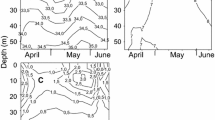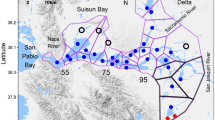Abstract
The acorn barnacle, Semibalanus balanoides, is thought to release larvae in response to phytoplankton blooms, but there is evidence that another, unidentified cue for release may exist. We conducted high-frequency sampling in Little Harbor, Massachusetts, USA, to determine whether early-stage larval abundance was related to several environmental variables, and to characterize vertical distributions of the larvae. Larval concentrations peaked at 2.52 and 1.02 individuals l−1 during two storms. Larvae were more abundant near the surface than near the bottom. We suggest the hypothesis that turbid conditions and upward-swimming behavior may protect newly-released larvae from predation and cannibalism. Future studies should test this hypothesis with barnacles and other invertebrates.




Similar content being viewed by others
References
Amend M, Shanks A (1999) Timing of larval release in the mole crab Emerita talpoida. Mar Ecol Prog Ser 183:295–300
Barnes H (1956) Balanus balanoides (L.) in the firth of clyde: the developmental and annual variation of the larval population, and the causative factors. J Anim Ecol 25:72–84
Barnes H (1957) Processes of restoration and synchronization in marine ecology. The spring diatom increase and the “spawning” of the common barnacle Balanus balanoides (L.). Ann Biol 33:67–85
Barnes H (1962) Note on the variations in the release of nauplii of Balanus balanoides with special reference to the spring diatom outburst. Crustaceana 4:118–122
Barnes H, Barnes M (1958) The rate of development of Balanus balanoides (L.) larvae. Limnol Oceanogr 3:29–32
Barnes H, Barnes M (1959) A comparison of the annual growth patterns of Balanus balanoides (L.) with particular reference to the effect of food and temperature. Oikos 10:1–18
Barnes M, Barnes H (1982) Effect of turbulence on the feeding and moulting of the cirripede Semibalanus balanoides (L.) given an algal diet. J Exp Mar Biol Ecol 65:163–172
Bertness MD, Gaines SD, Wahle RA (1996) Wind-driven settlement patterns in the acorn barnacle Semibalanus balanoides. Mar Ecol Prog Ser 137:103–110
Bousfield EL (1955) Ecological control of the occurrence of barnacles in the Miramichi Estuary. Bull Nat Mus Can 137:1–69
Chree C (1912) Some phenomena of sunspots and of terrestrial magnetism, at Kew observatory. Philos Trans R Soc Lond Ser A 212:75
Crisp DJ (1956) A substance promoting hatching and liberation of young in Cirripedes. Nature 178:263
Crisp DJ (1959) The rate of development of Balanus balanoides (L.) embryos in vitro. J Anim Ecol 28:119–132
Crisp DJ (1962) The planktonic stages of the Cirripedia Balanus balanoides (L.) and Balanus balanus (L.) from north temperate waters. Crustaceana 3:207–221
Crisp DJ (1964) Racial differences between North American and European forms of Balanus balanoides. J Mar Biol Assoc UK 44:33–45
Crisp DJ, Patel BS (1960) The moulting cycle in Balanus balanoides L. Biol Bull 118:31–47
Crisp DJ, Spencer CP (1958) The control of the hatching process in barnacles. Proc R Soc Lond B149:278–299
Fish CJ (1925) Seasonal distribution of the plankton of the Woods Hole region. Bull US Bur Fish 41:91–179
Frolander HT (1955) The biology of the zooplankton of the Narragansett Bay area. Dissertation, Brown University
Gran HH, Braarud T (1935) A quantitative study of the phytoplankton in the Bay of Fundy and the Gulf of Maine (including observations on hydrography, chemistry, and turbidity). J Biol Board Can 1:279–467
Harms J (1984) Influence of water temperature on larval development of Elminius modestus and Semibalanus balanoides (Crustacea, Cirripedia). Helgol Meeresunters 38:123–134
Ladah LB, Tapia FJ, Pineda J, Lopez M (2005) Spatially heterogeneous, synchronous settlement of Chthamalus spp. larvae in northern Baja California. Mar Ecol Prog Ser 302:177–185
Lang WH, Ackenhusen-Johns A (1981) Seasonal species composition of barnacle larvae (Cirripedia: Thoracica) in Rhode Island waters, 1977–1978. J Plankton Res 3:567–575
Licandro P, Ibañez F, Etienne M (2006) Long-term fluctuations (1974–1999) of the salps Thalia democratica and Salpa fusiformis in the northwestern Mediterranean Sea: relationships with hydroclimatic variability. Limnol Oceanogr 51:1832–1848
Macho G, Molares J, Vazquez E (2005) Timing of larval release by three barnacles from the NW Iberian Peninsula. Mar Ecol Prog Ser 298:251–260
Morgan SG, Christy JH (1996) Survival of marine larvae under the countervailing selective pressures of photodamage and predation. Limnol Oceanogr 41:498–504
Navarrete SA, Wieters EA (2000) Variation in barnacle recruitment over small scales: larval predation by adults and maintenance of community pattern. J Exp Mar Biol Ecol 253:131–148
NOAA (2010a) Tidal station locations and ranges. http://tidesandcurrents.noaa.gov/tides06/tab2ec1b.html#12. Accessed 10 March 2010
NOAA (2010b) Climatic wind data for the United States. http://www.ncdc.noaa.gov/oa/mpp/wind1996.pdf. Accessed 10 March 2010
Onitsuka T, Kawamura T, Horii T, Takiguchi N, Takami H, Watanabe Y (2007) Synchronized spawning of abalone Haliotis diversicolor triggered by typhoon events in Sagami Bay, Japan. Mar Ecol Prog Ser 351:129–138
Parmenter CM, Bothner MH, Butman B (1983) Characteristics of resuspended sediment from Georges Bank collected with a sediment trap. Estuar Coast Shelf Sci 17:521–533
Pineda J, Riebensahm D, Medeiros-Bergen D (2002) Semibalanus balanoides in winter and spring: larval concentration, settlement, and substrate occupancy. Mar Biol 140:789–800
Pineda J, Starczak V, DiBacco C (2004) Biocomplexity: regional variability in reproductive timing, settlement and recruitment of an intertidal barnacle in the US northeast coast. Abstract. ASLO/TOS Ocean research conference. Honolulu, HI
Pingree RD, Mardell GT, Reid PC, John AWG (1986) The influence of tidal mixing on the timing of the spring phytoplankton development in the Southern Bight of the North Sea, the English Channel and on the northern Armorican Shelf. In: Bowman MJ, Yentsch CM, Peterson WT (eds) Lecture notes on coastal and estuarine studies, tidal mixing and plankton dynamics, vol 17. Springer, Berlin, pp 164–192
Prager MH, Hoenig JM (1989) Superposed epoch analysis: a randomization test of environmental effects on recruitment with application to chub mackerel. Trans Am Fish Soc 118:608–618
Singarajah KV, Moyse J, Knight-Jones EW (1967) The effect of feeding upon the phototactic behaviour of Cirrepede nauplii. J Exp Mar Biol Ecol 1:144–153
Singh YP, Badruddin (2006) Statistical considerations in superposed epoch analysis and its applications in space research. J Atmos Sol Terr Phys 68:803–813
Sokal RR, Rohlf FJ (1995) Biometry: the principles and practices of statistics in biological research, 3rd ed. W.H. Freeman, New York
Starr M, Himmelman JH, Therriault J-C (1991) Coupling of nauplii release in barnacles with phytoplankton blooms: a parallel strategy to that of spawning in urchins and mussels. J Plankton Res 13:561–571
Townsend DW, Spinard RW (1986) Early spring phytoplankton blooms in the Gulf of Maine. Cont Shelf Res 6:515–529
Townsend DW, Cammen LM, Holligan PM, Campbell DE, Pettigrew NR (1994) Causes and consequences of variability in the timing of spring phytoplankton blooms. Deep Sea Res I 41:747–765
Acknowledgments
We are grateful to our field assistants, especially Luc Mehl, Michael Holcomb, Erin Banning, and Christopher Waters for their help with the high-frequency plankton sampling. We would like to thank Elizabeth Gardner for allowing us access to her dock for sampling. We also thank Drs. Victoria Starczak, Kristen Davis, and Molly Jacobs for their helpful comments during the preparation of this manuscript. Support for this work came from a National Science Foundation Graduate Research Fellowship and a student award from the Coastal Ocean Institute at the Woods Hole Oceanographic Institution (both to JG). We thank three anonymous reviewers for comments that improved this manuscript. Our experiments and sample collections comply with the laws and regulations of the United States of America and the State of Massachusetts.
Author information
Authors and Affiliations
Corresponding author
Additional information
Communicated by P. Kraufvelin.
Rights and permissions
About this article
Cite this article
Gyory, J., Pineda, J. High-frequency observations of early-stage larval abundance: do storms trigger synchronous larval release in Semibalanus balanoides?. Mar Biol 158, 1581–1589 (2011). https://doi.org/10.1007/s00227-011-1671-1
Received:
Accepted:
Published:
Issue Date:
DOI: https://doi.org/10.1007/s00227-011-1671-1




